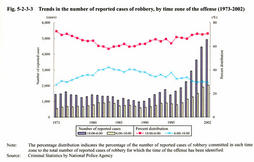| Previous Next Index Image Index Year Selection | |
|
|
2 Trends in Robbery from the perspective of the time zone of the offense Fig. 5-2-3-3 shows the trends in the time zone in which robbery was committed. According to the trends in the number of reported cases and the percent distribution thereof by time zone, i.e. daytime (from 6:00 a.m. to 6:00 p.m.) and nighttime (from 6:00 p.m. to 6:00 a.m. the next morning), the number of reported cases of robbery committed in the nighttime turned upward after remaining flat or declining slightly over the period from 1973 to 1989. The number has been increasing significantly since 1996 while the percent distribution has been on the rise since 1984.
In more detail, over the period from 1983 to 2002, the number of reported cases increased 3.7-fold for robbery committed in the time zone from 6:00 p.m. to 10:00 p.m., 4.4-fold for robbery committed in the time zone from 10:00 p.m. to 2:00 a.m. in the next morning, and 3.0-fold for robbery committed in the time zone from 2:00 a.m. to 6:00 a.m. Fig. 5-2-3-4 shows the percent distribution of the number of reported cases by time zone, focusing on 1983, 1993, and 2002. The percentage of robbery committed in the nighttime has been increasing gradually from 57.8% in 1983 to 64.0% in 1993 and 70.7% in 2002. In particular, the percentage of robbery committed late at night, from 10:00 p.m. to 2:00 a.m. in the next morning, has been rising, from 19.6% to 26.2% and 28.9%. Considering these trends in combination with the upward trend in the number of reported cases of street robbery in the previous subsection focusing on the scene of the offense, the recent upward trend in the number of robbery cases may be largely due to the rapid increase in the number of robbery cases committed on the street late at night. This suggests that, along with the increase in the number of stores that are open late at night, such as overnight restaurants and 24-hour convenience stores, people go out late at night more frequently and the number of robbery cases targeting these people is increasing. Fig. 5-2-3-3 Trends in the number of reported cases of robbery, by time zone of the offense (1973-2002) Fig. 5-2-3-4 Percent distribution of the reported cases of robbery, by time zone of the offense (1983, 1993, 2002) |

